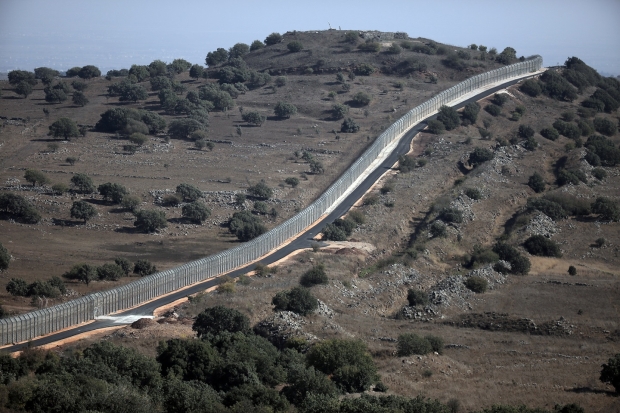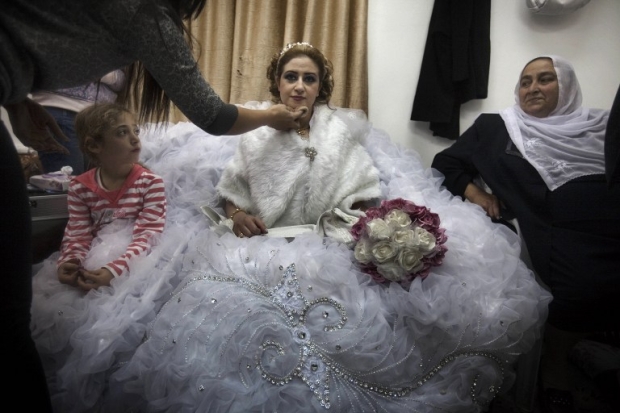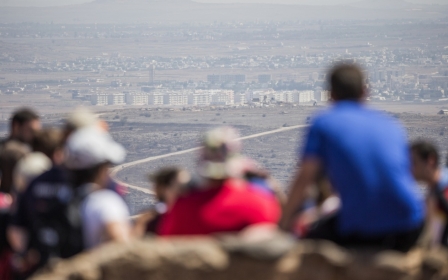Dreams of homeland in the valley of tears

MAJDAL SHAMS - The drive up the steep slope to Majdal Shams, situated in the centre of Israeli-occupied Golan, a slight distance from Quneitra and Syria, leads to a white gate, which opens up to reveal the dreamlike village of Nevi Avit - with its perfectly cut lawns and sparkling fountains, it resembles an exclusive ski resort in the Alps.
“It’s been a Jewish settlement only since the 1970s,” said Salman Fakhreddin, public relations officer of Al-Marsad, the Arab Human Rights Centre in the Golan. “It was built on the rubble of Jibbata Zeit, one of the 134 Syrian villages destroyed by Israeli troops in 1967.”
Internationally recognised as Syrian territory, this strip of Golan was occupied by Israel during the Six Day war of 1967. Following the Yom Kippur war in 1973, Israel agreed to return about five percent of the territory to Syrian civilian control (this was later incorporated into a demilitarised zone that runs along the ceasefire line, which is now under the control of UN peacekeeping forces.) However, the largest portion of this strategic plateau was illegally annexed by Israel in 1981, in a move repeatedly rejected by the UN and the international community. Consequently, Syrians are still suffering the impact of this often-forgotten occupation.
But, despite not being recognised by the international community, and being against international law, Israel has deemed the Golan Israeli territory within Israeli jurisdiction, and therefore not occupied land, since the enactment of the Golan Heights Law 1981.
There is a range of reasons why the Golan Heights is valuable to the Israelis. According to the Torah, Mount Hermon - whose southern slopes extend to Israeli-occupied Golan - is the first mountain that will be seen by the Jewish people when they return to Israel. From a military standpoint, Israel can prevent Syrian attacks into northern Israel through its control of the Golan.
With a much higher level of precipitation compared to Israel, Golan's water is also a critical factor. Up to a third of the water used in Israel comes from the Golan area, which has become an indispensable water supplier - and one that may have been envisioned for some time.
“The whole economic future of Palestine is dependent upon its water supply for irrigation and for electric power, and the water supply must mainly be derived from the slopes of Mount Hermon, from the headwaters of the Jordan and from the Litani river,” said Chaim Weizmann, a Zionist leader at the time of the Balfour Declaration in 1917, in a letter to the British prime minister, David Lloyd George.
“Israel never considered giving the Golan back to Syria,” said Fakhreddin. “When the war was over, in 1973, Israel returned Sinai to Egypt and promised to do the same with Syria but, in fact, it had already started building settlements in the Golan.” Up to 17 Jewish settlements were built in the 70s and a further nine in the 80s.
“It’s true that there was some talking about giving up the Golan but it was too risky for Israeli people,” said Israeli security analyst and president of Tel Aviv-based geopolitical risk and research consultancy, “Levantine Group,” Daniel Nisman. “The main reason for creating a buffer zone in the Golan was security and, to be followed, its importance as a water source for the rest of the country.”
In the Golan, the Syrian inhabitants’ situation is unique: they live under occupation, which they fully reject and, sometimes, fight against, yet the improvement of their situation and their fates are inextricably tied to events in the larger Syrian homeland from which they are severed.
Salman Ibrahim’s farm is a short ride from the centre of Majdal Shams. If it weren’t for the electronic wire marking the ceasefire line with Syria, which dangles a few metres away from Ibrahim’s property, you would envy this man who, despite some physical disability derived from a car accident, decided to spend his life immersed in these lush rolling hills.
“Before settlers started yielding apples,” Ibrahim explained, “we used to be the biggest producers both in Israel and Syria. But now settlers cultivate more than three times the size of land we have, consume most of the available water, and sell apples with a higher quality and a cheaper price than ours.”
According to the World Zionist Organisation (WZO) Report, in 1973-1974 Jewish settlers could count up to 17 times more water per capita than the indigenous Arab inhabitants, whilst today 4:1 is the estimated disparity of water allocation between settler and the Arab farmers, according to the Arab population of the Golan.
Water, which doesn’t come directly from natural resources, is purchased from the Israel water supplier, Mekorot, at an average of £0.7 per cubic metre by Syrians, and half that price by Jewish settlers, who can also purchase water, at an even cheaper price, from the settlements-only cooperative, Mei Golan.
“If it goes well, we sell up to 100 boxes of apples per year at £170 each but, as we have to pay £85/100 per box for water, chemicals and additional labour, and the sale competition with Jewish settlers is very high, we can’t live out of agriculture,” said Ibrahim, who makes up his wages by working as a truck driver.
By comparison, 30-50 percent of Israeli fruits and vegetables are produced in the Golan, and a substantial quantity of their wine too. Although Nisman acknowledged that the Golan’s land is very fruitful, he disagreed with Ibrahim, and said that, “Jewish settlers living in the Golan are among the wealthiest in Israel,” and pointed out, “Despite the benefits received by the government, they are working class people with a middle-low income.”
Until 2005, the Arab population of the Golan was not allowed to sell its apples to Syria and, since the war in 2011, the border has been almost entirely shut and the fruit exports have significantly slowed, according to Nisman.
Furthermore, the occupation has split families. Between 1967 and 1981, family reunification was made possible in a few cases but, for Syrians who wanted to move back to the Golan, it was under the condition that it was a “one-way ticket.” Ibrahim’s brothers were not in the position to leave Damascus behind forever.
“I feel really lonely,” said Ibrahim. “Can you believe I’ve only seen my two brothers once since 1967? At the end of the war, they both went back to Damascus - the older was a soldier in the Syrian army and the younger a student in Yugoslavia - and they have never been able to come back again.”
Most of the families living in the occupied Golan today are separated from family as a consequence of the forced eviction and dispersion of 146,000 Syrians in 1967. In 2007, family reunification was prohibited for all Arabs in Israel and in the occupied territories, including the Golan. There are stories of families living only a few kilometres apart, unable to access modern social media that communicate through megaphones which are placed on two opposite sides of a hill named the “valley of tears.”
The Syrian resistance
Throughout the years, Syria tried to cultivate the loyalty of the Golan people, by rewarding and empowering its students, who were the most active in pro-Syrian organisations in the Golan Heights, through scholarships, and by purchasing apples from the Druze farmers at a better price than the one they would get in the already saturated and highly competitive Israeli market.
Furthermore, in 1982, a new policy offered Syrians Israeli citizenship, but the majority of the Syrian population in the Golan refused the offer, and those who became citizens - and accepted the Israeli economical benefits promised in exchange - were labelled as terrorists.
These two examples show how the Syrian population used to be united around its Syrian identity and in its fight for the reunification with its motherland. However the 2011 civil war has changed all that.
Sodkhi Makht and his father, Suleiman, and Najah Abu Jabal, live side by side in Majdal Shams, but haven’t talked to each other for ages.
“I was born in 1967 and I witnessed with my own eyes what the Israeli occupation has been like,” Makht said. “While the Jewish settlements, with their fancy gardens and lands, would expand more and more, we Syrians would be squeezed inside our own land.”
“I remember that at school we were prevented from saying we were Syrians, otherwise they would send us straight home, or to the police station,” he continued. “And then, because my father and uncle were in the Syrian army, Israeli forces would constantly break into our house, until they eventually jailed them.”
When citizenship was offered in 1982, for Makht, “this last provocation was enough to react.” Together, with another 11 men, he founded the Syrian Resistance Movement, a military organisation aimed at fighting the occupation in the Golan Heights.
After a few operations against the Israeli army, which didn’t result in any bloodshed but proved the movement’s military capability, Makht was identified as one of the masterminds behind the attacks and was arrested in 1985. He was freed in 2012 after 27 years of confinement.
On the other side of the road from Makht’s home lives Abu Jabal, a 63-year old widow.
“The 1967 occupation was a shock for us,” she told MEE. “I wanted to continue studying and travelling across Lebanon and Syria, the countries my parents came from, but I ended up becoming an elementary school teacher when I was only 17 years old.”
“We thought that state of things would only last for a short period of time, and Israel took advantage of it by interrupting the normal stream of our lives,” she added.
While Abu Jabal’s husband was arrested in 1970, 1972 and again in 1973, because of his strong Nasserite views, Abu Jabal was carrying out her own personal resistance.
She was involved in underground groups, where she would write leaflets in support of her motherland, sew Syrian flags, which were banned at that time, and teach children how to respond to random interrogations carried out by the Israeli army.
Eventually, she was dismissed from school because she opposed, through strikes and demonstrations, the change of curricula imposed by the Israeli authorities.
Up to 2011, Makht and Abu Jabal have had complementary roles in the Syrian struggle, but the Syrian war has soured their relationship.
On the one hand, we have a man who believes in the power of the Syrian army and his president as the only way out from the current state of affairs. “I have no doubts that President Assad will rescue us, once he sorts out the situation back home,” said Makht.
On the other hand, there’s a woman who doesn’t endorse President Assad, as “I saw with my own eyes, in 2004, how the Syrian people were oppressed by him,” but looks with similar despair at an initial peaceful uprising turned into hopeless bloodshed.
Today, the situation in the Golan Heights has reached a deadlock. The Israeli occupation moves forward, while the Syrian community is small, fractured and depending on a motherland that faces major challenges.
New MEE newsletter: Jerusalem Dispatch
Sign up to get the latest insights and analysis on Israel-Palestine, alongside Turkey Unpacked and other MEE newsletters
Middle East Eye delivers independent and unrivalled coverage and analysis of the Middle East, North Africa and beyond. To learn more about republishing this content and the associated fees, please fill out this form. More about MEE can be found here.





